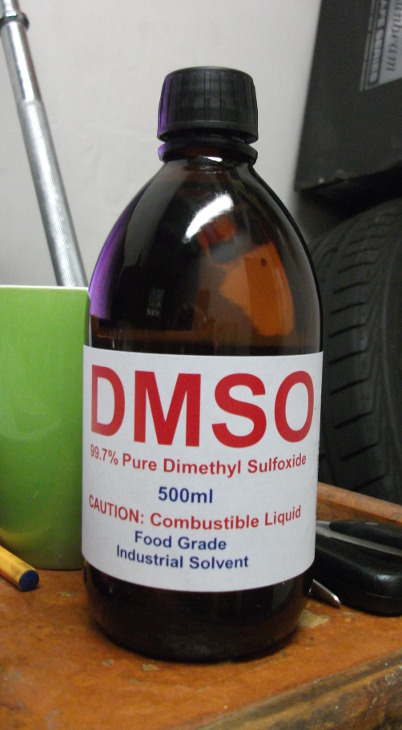What are you training for?
What are you training for?
I would hope the answer to that question is long term health & physical well being.
Well no thats why people should train & its why I train but many people get side tracked. Even I get side tracked too.
Some people train to improve sports skills, to get or stay in a job, to score the opposite sex etc.
So this in turn turns any sports advice upside down. For example I just saw a twitter tweet that got my goat. it was quoting a study showing greater gains from whole body training 3x per week than split training.
Now most people will see that and think wow – thats me I’ll train just 3x per week whole body and get better gains
The study was for 3 months. This is the maximum length that a whole body routine is recommended for beginers.
Its only after that you are meant to begin split training. But people will misinterpret the research because of the way it was presented.
OK lets chuck in a couple more of these paradigms – backed by research papers.
Lets say they also choose to train just with sandbags because another paper or trainer said it is better.
Lets say they choose to follow a high fat diet because some other guy says cholesterol doesnt matter.
Now if you combine enough of these half assed half researched idea’s together & you will end up with a pretty FUBAR athlete.
They may shine like a star briefly or even for a few years. Then kaput.
Enough people have trained with weights & enough research has been done that the standard principles are well defined.
Long term whole body training leads to increased injury & burnout & stagnation of gains. Its common knowlege.
Cholesterol is linked to heart disease – its a fact – accept it.
On and on. Its no good to look at a 3 month study and base your training fully upon than. Or a limited study in a specific population with a genetic disposition.
There are basic training principles that work. If you dont follow them you will get injured & ill more frequently.
If you train for a sport or career your training will be out of skew with whats best long term for your body.
Simple facts.
The myth of “functional” training
The word functional has a dual meaning. It can mean functional as opposed to dysfunctional or it can mean functional as in serving a narrow defined function.
The function of the organism may be compromised by a narrowly defined function.
So when these guys say they are into “functional training” do they mean they are into training you as a functional organism?
Or are they training you to perform a specific function?
Two totally different things with different outcomes.
Most of these functional training programs are in fact to train people for a specific job or to repair an injury.
They are not an over all training program for a fully functional human being. They can not and never will be.
So if you want a long term program to make you the best functional organism – thats traditional bodybuilding.
If you want to become a tactical operator, repair a leg injury, be good at football etc – take up some form of “functional” training.
But just be aware that its functional in name only & in the long term is dysfunctional.
Special forces operator training programs
There are some really decent special forces fitness programs floating around on the net these days.
A couple of very simple effective programs are here for you to download.
Selected: Selected Ebook
How to use this course.
A very successful Olympic running coach once said that the better prepared athlete would always beat
the faster athlete. We think he’s right. In the US Army Special Forces selection and assessment course
you may be competing for selection against faster or stronger servicemen. But, if you have completed
this course, done the workouts and absorbed the educational material – and put into practice what you
have learned – you will be one of the best prepared applicants and more likely to succeed.
SFAS Training Manual: Training for the tactical athlete
SFAS 14 week strength :SFAS 14 Week Strength
SFAS 6 week strength: SFAS 6 Week Strength
SFAS 14 week prep: 14 week prep
SFAS 10 week prep: 10 week prep
Rotator cuff update
Four months since rotator cuff injury occured.
Two months back I wrote that I expected to be pain & inflammation free by now.
When I first got injured I thought the whole thing would be gone by now.
Well I am pain & inflammation free so long as I dont aggravate it. My ROM is 90% where as for 3 months it was 50%.
I can now gently stretch on a pullup bar some what restrained without pain. Certainly I can not free hang yet.
I would place that as two months away.
I can do restrained pressups and kettlebell rows. I can even rack the 16kg kettlebell on the injured side but only a few reps & wont be doing any ballistic stuff for weeks if not months.
I did put all of my gear up for auction & it didnt sell so I will keep it all for time being. I am only training shoulders once per week from now on for strength or muscle mass.
Obviously shoulder rehab is daily in some form.
I have found a new physio that does Active Release Therapy so I will start seeing the new one. Old physio was good but not specialized for the next phase.
I will join the closest gym. 3 minutes from my door & train there daily. No need to train shoulders at the gym as I have all of the gear at home.
My training will be rehab, bodybuilding & cardio focused.
Hopefully in May or June I will be healed up. I still intend to get a platlete shot too. Possibly into both shoulders if ultrasound reveals damage in the right too. Certainly the left will be getting an injection.
How will I split my training?
Well maybe variations of the following
Grip day
Shoulder day
Upper Arm day
Leg day
Chest day
Back day
Cardio & rehab on most days
I also need to get back into a proper stretching / yoga routine
As many sauna’s as I can fit in
How to rig your heavy weight vest for safety
When I say heavy I mean upwards of 50 lbs. Prior to my shoulder injury I was training with 80lbs for an hour at a time minimum.
So there are two ways a weight vest will injure you:
1. Excessive Occlusion
This is when the circulation cuts off in your arms because of the pressure on your shoulders. You will have totally numb arms. Even a 40 lb vest will do this after 3-5 hours.
2. Putting it on & off
This is how I tore my rotator cuff. 50, 60 80 lbs is not very heavy for a dumbell or kettlebell. This is a floppy uncontrollable odd shaped object.
There are a couple of videos online for technique to put a vest on – yeah sure if its 20 lbs & of the design shown.
The fact is once you are up to 50 lbs even with a good vest & proper form these techniques will kill your shoulder joints.
The Solutions:
1. Shoulder pads
MIR now has shoulder pads
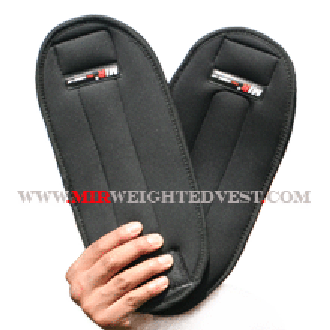
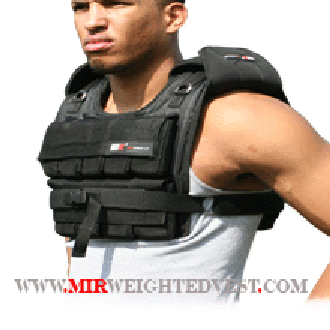

OK awesome a must have
2. A Weight Vest Rack
Yet to be built – heres what you need to do. See those shoulder pads above. Imagine if they were a little more robust at the top where the velcro attaches them. Imagine if they were robust enough to support the full weight of the vest held on two protruding bars.
These two bars could be sticking out of a wall or on a rack.
You would simply walk forward duck under the vest & slip your head inside. Then step back moving the vest off the bars. Your vest would be on with zero dangerous shoulder movement.
Taking it off would be just as easy.
Once my rotator cuff heals up I will build this setup. Using a heavy vest any other way is like trying to squat but always lifting the bar from the ground & onto your back. That is madness.
Here are the two methods of putting your vest on that WILL NOT WORK with a heavy vest EG: 50lbs+
Same with the super hanger – useless with a real heavy vest
Whats needed is a Weight Vest Rack
A search online reveals the complete wrong design weight vest rack
This is retarded. Totally the wrong design & pointless. You need the vest to be suspended from two bars at a right angle to the shoulders. Then you just slip up and under & the vest is on. Taking it off would be even easier as you would simply walk forward & slide the vest shoulder pads onto the two bars.
UPDATE:
OK I had an evenings sleep & came up with a quick simple solution. First up you need a squat rack. These are cheap. You also need a dipping attachment for the rack. Cheapest I can find are pictured below:

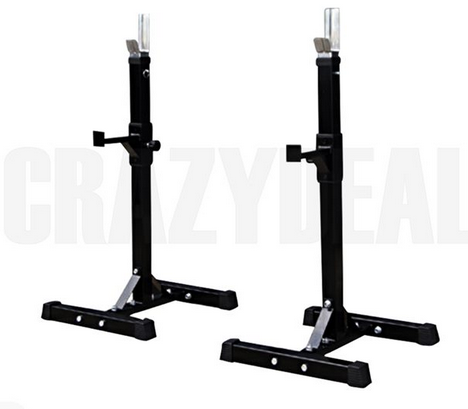
I can pick those up for under $200 brand new locally
OK so you will need a cross bar to attach the dip bars to. Thats just square steel tube which will need to be secured to the rack.
The rack incedentaly extends to shoulder height – its for squating.
OK so next you want to get a pair of the mir shoulder pads. I did look into backpack shoulder strap pads but these seem less heavy duty & are the wrong shape. Go with the MIR ones.
Looking at the MIR pads they may not actually be long enough. If so use a Tactical Waist Padded Belt.

Now you want some gorilla glue or liquid nails. See how the MIR pads connect with velcro? You are gunna glue them together glued on forever.
DO NOT glue them to the vest straps. Just glue them shut. before you do make sure the two dip bar prongs will slide in with the vest on your shouders.
OK finally get some duct tape & tape around the whole shoulder pad until you are confident its strong enough to hold 100+ lbs on the rack for months at a time.
Thats it man !!! You now have the safest possible setup for weight vest training.
One caveat is that the duct tape may detract from the padding. You can carefully duct tape just the top part of the padding looping it around. Good luck.
The padding is OK if its loose at the top & you will of course still want it to be comfortable. Better get some real good glue.
FINAL WARNING!!!
Had I done this two years ago I would not now have a torn rotator cuff.
The problem with Kettlebell Training
I took up Kettlebells when my favorite gym closed. I had trained there for 25 years. So over the course of 5 years I built up to owning 8 KB’s.
Ranging from 40kg down to 16 kg. I also got the best weight vest on the market. The MIR 140 & a lighter chinese vest.
This was after 27 years of regular bodybuilding style training using split routines & all of the bodybuilding principles.
So I kind of got into crossfit / functional training & neglected many of those bodybuilding principles which had served me so well.
So whats wrong with the kettlebell based approach ?
Over Training of the Shoulders
The shoulders really only need one specialized workout per week. Chest, back & arm days will also hit the shoulders to a great extent.
I found that with kettlebells & weight vests I was training anything from 3 to 6 days per week & hitting the shoulders hard every single workout.
Finally after five years of this I have blown my tendons in the left shoulder.
All Kettlebell focused guys are guilty of this. Many dont use weight vests but are hanging bar or dip or ring fanatics.
So the shoulders get hammered – its over training.
I currently have all of my equipment up for auction. Kettlebells, vests & clubbells.
I actually only should be using this gear once per week on shoulder day. But for some blind dumb reason I slipped from my proven good bodybuilding habits and trained the hell out of my shoulders.
So if the auction doesnt close thats it – I will use KB’s or the vest once per week only.
Other days are spent at the gym doing legs, chest, back, arms etc. Now the only three body parts you cant really train with his gear are back, chest and legs.
I think with bands & dumbells you can hit the arms just fine. KB’s & hanging bar certaily hit the shoulders. Mid section there is plenty of home gear same for grip.
But back & legs probably constitute most of your muscle mass. Sorry but pullups, pressups & hindu squats dont cut it.
You need to bench press, squat or leg press & do lat pulldowns –> all of it heavy.
So the kettlebell fanatics have things out of focus & so do crossfit. The injury rate for crossfit is way way higher than conventional bodybuilding.
Olympic lifting also has a higher injury rate.
There is nothing wrong with kettlebells or crossfit but they should not be your only training regime. So you may do them on one day per week. Not two or three – ONE DAY.
You may also do a binge. A two week program of KB or crossfit style training 3 times per year is fine.
But I just did this crap day in & day out for five years. Now I have paid the price with a tendon injury.
Dont be like me. Honour your body & the bodybuilding principles. Balance your training correctly.
Time to drop Kettlebells?
My training has been Kettlebell & weight vest based for about five years. Now I have torn my tendons in my shoulder I am strongly urged to return to conventional bodybuilding.
This will mean selling my vests, kettlebells and clubbells and returning to the gym.
Back to dumbells, barbells and machines for 2017. I’m going to do it & my focus for cardio will be indoor rowing & outdoor cycling.
It will mean isolation training and a four or five day split routine. No more functional training. No more full body workouts. No more crossfit style workouts.
Call it periodization if you want but I am going to totally change how I train this coming new year.
Kettlebell based training is overtraining for the shoulders. Weight vests just make it worse. It was fun but its time for me to return to that which is best.
Healthy bodybuilding and cardio.
…But I’m about four months into healing this injury now. In another 2 months I will be able to comfortably rack & press the KB’s again with light weight. I can rack the 16kg now with my injured shoulder without pain.
Its a difficult decision that would be much easier if there was a nearby gym I really like. But there is not.
If I do continue with the KB’s and vests there will be some big changes safety wise. This will mean adding shoulder braces, slowly building up to greater weights and much more attention to joint health. There does not seem to be any safe way to put a heavy and awkward vest on or off.
Time will tell & this injury is so inconvenient that a repeat is definitely not acceptable.
Training revamp
As you know from the last couple of posts I am half way through recovery from a rotator cuff tendon tear.
As a consequence of this injury my upper body strength training has decreased in volume substantially.
For 3 months I did not raise my left arm above shoulder height at all. I now have a 15% decrease in range of motion when extending the arm over head.
I expect that to mend fast once I am able to do bar hangs and pull ups again but that is 3-4 months away.
So its time to refocus my training so I can remain very fit & active but not aggravate my shoulder.
My plan is to greatly increase my cardio training while I have the opportunity. This will be a 4-5 month program after which I should be back to my normal routine.
Of course if I reinjure the shoulder I am screwed.
So I want to do 90 minutes cardio per day. I want to do 80% light easy cardio & 20% intense HIIT per week.
Thats 4 days easy cardio & 2 days HIIT & strength style.
I also want to ramp up my sauna time.
Cardio will be in the form of skipping (if I can do it – have not tested the shoulder yet), cycling, KB swings and rebounder.
I may do some easy barefoot grass runs too.
HIIT will largely be Kettlebell and Clubbell work & other calisthenics stuff.
OK thats fairly standard training with a cardio focus. I will also ramp up my flexibility training. Isometrics etc.
Now what will be different is an introduction of preventative rehabilitation training.
I touted this in a post many months ago. Using medical & physiotherapy rehabilitaion research & programs to take your body to a whole new level of fitness.
Well I posted but did not do – now months later have two torn tendons.
Now I must take my own advice.
I have done rehab on the shoulders for 3 months now with a physiotherapists guidance.
Here are the main area’s I want to focus on:
1. Detoxification – This is the first step & I did my major detox a year back. I simply need to make long duration sauna more frequent.
2. Joint specific preventative rehabilitation.
– Shoulders
– Knees
– Hip / Pelvis
– core / lower back
These are the main points of joint failure. I simply intend to train using the full rehabilitation protocols for people that have injured these joints.
Hence avoiding future injury. This will include an over all strategy for tendon strengthening most probably involving isometrics.
3. Cardio pulmonary rehabilitation
4. Grip training – I already have a good grip & train it regularly but it should be included by everybody.
So what I am planning to do here is pre-empt & prevent injury by giving my body a conditioning buffer.
I’m 48.5 years old not the 28 year old infantryman I once was. Not the 35 year old stallion any more. But in my psyche I still am young & virile.
I also know how to supplement & self medicate to rev up my hormone levels & that should definitely be done with the above regimen.
So for a senior athlete these extra injury prevention measures are required if you want to retain stallion status.
Lets face it most of us are negligent and wont take the required safety measures.
I say alter your training and fit in the rehab protocols BEFORE you get injured. Because a 9 month lay off with a torn tendon really does suck.
***WARNING***
One warning about isometrics & joint strength. Isometrics really hit the tendons & are magnificent for strengthening the tendon structure. BUT if you do your isometrics in positions that compromise your joints you will suffer joint & tendon failure.
For some time I was doing isometrics in an overhead press position. This is actually contradictory to rotator cuff anatomy as it is an impingement position. Did this contribute to my injury? I think it probably did & I had no idea what I was doing at the time.
This means isometrics must not simply mimic positions held in certain exercises.
Isometrics must be designed around the functional anatomy of the joint & copied from physiotherapy rehabilitation programs. Then you are safe.
Do not do haphazard, random isometric holds. Do not simply copy muscle building exercises to determine your isometrics positions.
Injuries suck
In my 32 year training history I have only had two serious injuries. The first was whiplash back in my army reserve days. Primarily this was caused by using a neck harness and doing 200 reps with 80lbs in the forward position only.
After a few months of doing this strength stunt a guy in the army put me into a headlock while wrestling. A few days later my neck was screwed. I went to a chiropractor and got an x-ray. My neck was straight like a broom stick.
It actually took me 5 years to get it fully pain free with no further recurrences.
Now I have torn two tendons in my rotator cuff on the left shoulder. As I often make money painting this is very not good and I have never had any shoulder problems prior to this at all.
Main culprit for this injury – very heavy weight vest training. The main problem is putting the thing on but I’m sure the duration of my sessions has not helped.
I have now done 3 months of physio and am about 60% healed up. But this is a debilitating injury and I need 100% repair. My next step is. Platelet Injection.
Fingers crossed that PRP treatment will get me over the recovery line.
Even Evander Holyfield & Vitali Klitschko had a torn rotator cuff & Vitali Klitschko boxed professionally for a further 13 years after rotator cuff repair.
Here is a great video on Rotator Cuff recovery:
My first day using DMSO
My first day using DMSO was a complete success. DMSO stings like sunburn at 100% dilution. It also turns the skin red just like sunburn. But that only lasts about 20 minutes. It gets itchy, prickly & stings. Then the stuff soaks into the skin – you dont rub it.
After 10 minutes the analgesic property is pretty much 100%. I could feel zero pain in my shoulder that has hurt for 11 weeks. I could even stretch in positions that would have dropped me to the floor in agony an hour earlier.
This analgesia lasts for 3-5 hours and is very pronounced. Yesterday I had the best workout I have had in 11 weeks – it was great.
You do need to be careful because there is such great pain reduction you dont want to forget you have an injury. The smell is there but not sickening to the user. I dont know how it would smell to another person. Probably quite bad.
As for the anti inflammatory effect it will take a couple of weeks to kick in I expect.
With DMSO you must be very careful not to contaminate it with any toxins. I intend to use Aloe Vera gel to help with the skin sting but I will only use 100% pure Aloe with no nasty chemicals added.
Same if you want to use it with vitamins etc. Only use a small amount as it will go straight into your blood using this stuff. Anything under 400 ng/mol molecular weight will absorb.
So by itself DMSO is non toxic but is as poisonous as anything mixed with it.
Large studies have shown 70-80% success for tendon tears & 80-90% for bursitis.
Here is the bottle I have:
And the purity level:
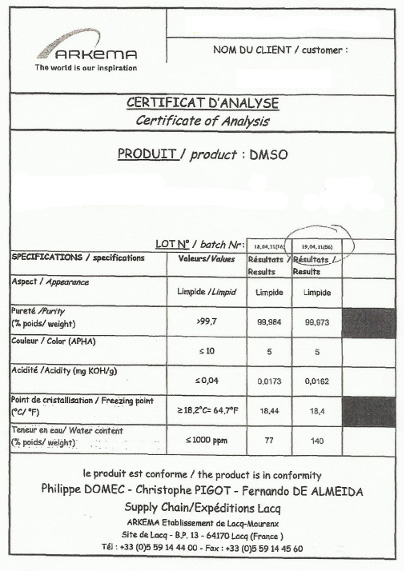
You need Collagen now – to save your joints
Collagen should be up to 30% of your daily protein. That means if you have 1 gram of protein per pound of body weight and weigh 200 lbs you should be having 66 grams of collagen.
Did you bother to check?
Have you ever bothered to supplement with collagen and do you even know how?
I bet for most of us the answer is no & yet we take creatine, whey protein, eat a lot of fruit and veges etc.
I have trained 32 years and didnt care less about collagen. Now I have had a rotator cuff tear for ten weeks and all of a sudden my attitude has changed.
If you want to retain your youth you better get serious about collagen intake.

So what is the best way to increase collagen to the extent that it is definitely 30% of your protein intake?
Gelatin
Yep good old common gelatin. Two kinds of it collagen hydrolysate & regular collagen (gellatin) are required.
I just went over the street to the asian food market & they have 3kg bags of gelatin for $70 – SCORE!!!
My collagen Hydrolysate I will get from the USA or aliexpress.
Here is the link $118 for an 8lb sack Collagen Hydrolysate

Now there are plenty of different suppliers so shop around
The bottom line is you need to be taking this stuff every day of your life & plenty of it.
If you dont? Well you may tear a tendon as I just did, you may get muscle sprains, breathing problems, heart disease. collagen is required by capiliaries. You will age & die sooner.
Just take the darn stuff.
